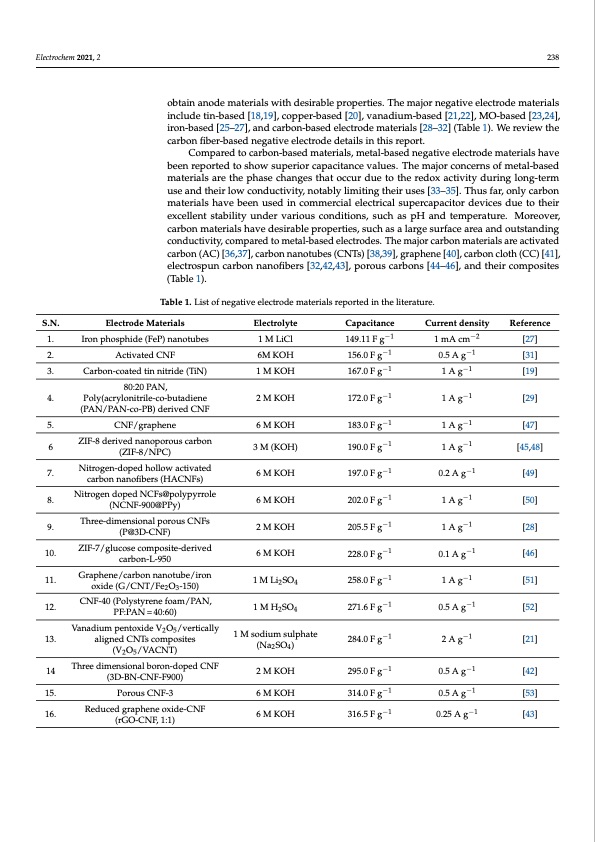
PDF Publication Title:
Text from PDF Page: 003
Electrochem 2021, 2 238 S.N. 1. 2. 3. 4. 5. 6 7. 8. 9. 10. 11. 12. 13. 14 15. 16. Electrode Materials Iron phosphide (FeP) nanotubes Activated CNF Carbon-coated tin nitride (TiN) 80:20 PAN, Poly(acrylonitrile-co-butadiene (PAN/PAN-co-PB) derived CNF CNF/graphene ZIF-8 derived nanoporous carbon (ZIF-8/NPC) Nitrogen-doped hollow activated carbon nanofibers (HACNFs) Nitrogen doped NCFs@polypyrrole (NCNF-900@PPy) Three-dimensional porous CNFs (P@3D-CNF) ZIF-7/glucose composite-derived carbon-L-950 Graphene/carbon nanotube/iron oxide (G/CNT/Fe2O3-150) CNF-40 (Polystyrene foam/PAN, PF:PAN = 40:60) Vanadium pentoxide V2O5/vertically aligned CNTs composites (V2 O5 /VACNT) Three dimensional boron-doped CNF (3D-BN-CNF-F900) Porous CNF-3 Reduced graphene oxide-CNF (rGO-CNF, 1:1) Electrolyte 1 M LiCl 6M KOH 1 M KOH 2 M KOH 6 M KOH 3 M (KOH) 6 M KOH 6 M KOH 2 M KOH 6 M KOH 1 M Li2SO4 1 M H2SO4 1 M sodium sulphate (Na2 SO4 ) 2MKOH 6MKOH 6MKOH Capacitance 149.11 F g−1 156.0 F g−1 167.0 F g−1 172.0 F g−1 183.0 F g−1 190.0 F g−1 197.0 F g−1 202.0 F g−1 205.5 F g−1 228.0 F g−1 258.0 F g−1 271.6 F g−1 314.0 F g−1 316.5 F g−1 Current density Reference obtain anode materials with desirable properties. The major negative electrode materials include tin-based [18,19], copper-based [20], vanadium-based [21,22], MO-based [23,24], iron-based [25–27], and carbon-based electrode materials [28–32] (Table 1). We review the carbon fiber-based negative electrode details in this report. Compared to carbon-based materials, metal-based negative electrode materials have been reported to show superior capacitance values. The major concerns of metal-based materials are the phase changes that occur due to the redox activity during long-term use and their low conductivity, notably limiting their uses [33–35]. Thus far, only carbon materials have been used in commercial electrical supercapacitor devices due to their excellent stability under various conditions, such as pH and temperature. Moreover, carbon materials have desirable properties, such as a large surface area and outstanding conductivity, compared to metal-based electrodes. The major carbon materials are activated carbon (AC) [36,37], carbon nanotubes (CNTs) [38,39], graphene [40], carbon cloth (CC) [41], electrospun carbon nanofibers [32,42,43], porous carbons [44–46], and their composites (Table 1). Table 1. List of negative electrode materials reported in the literature. 1 mA cm−2 [27] 0.5 A g−1 [31] 1 A g−1 [19] 1 A g−1 [29] 1 A g−1 [47] 1 A g−1 0.2 A g−1 [49] 1 A g−1 [50] 1 A g−1 [28] 0.1 A g−1 [46] 1 A g−1 [51] 0.5 A g−1 [52] −1 2Ag [21] 0.5 A g−1 [42] 0.5 A g−1 [53] 0.25 A g−1 [43] [45,48] 284.0 F g 295.0 F g−1 −1PDF Image | Review of Electrospun Carbon Nanofiber-Based Negative Electrode Materials

PDF Search Title:
Review of Electrospun Carbon Nanofiber-Based Negative Electrode MaterialsOriginal File Name Searched:
A_Review_of_Electrospun_Carbon_Nanofiber-Based_Neg.pdfDIY PDF Search: Google It | Yahoo | Bing
Sulfur Deposition on Carbon Nanofibers using Supercritical CO2 Sulfur Deposition on Carbon Nanofibers using Supercritical CO2. Gamma sulfur also known as mother of pearl sulfur and nacreous sulfur... More Info
CO2 Organic Rankine Cycle Experimenter Platform The supercritical CO2 phase change system is both a heat pump and organic rankine cycle which can be used for those purposes and as a supercritical extractor for advanced subcritical and supercritical extraction technology. Uses include producing nanoparticles, precious metal CO2 extraction, lithium battery recycling, and other applications... More Info
| CONTACT TEL: 608-238-6001 Email: greg@infinityturbine.com | RSS | AMP |